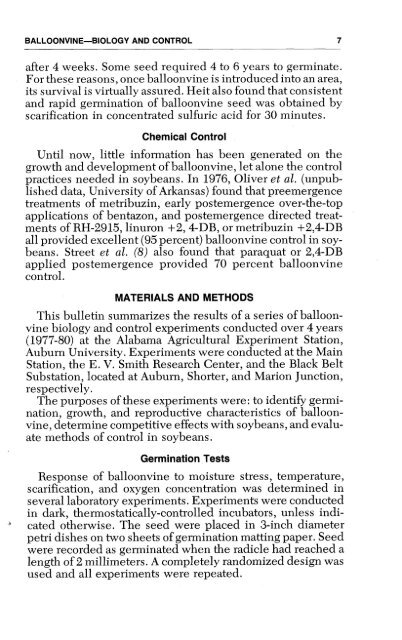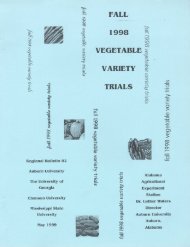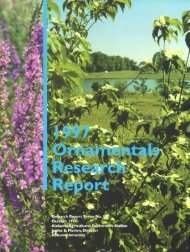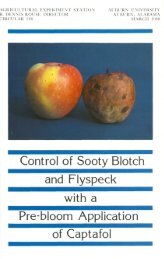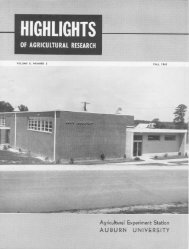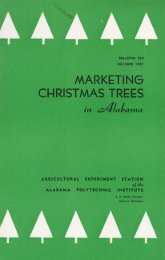Balloonvine Biology and Control in Soybeans - Auburn University ...
Balloonvine Biology and Control in Soybeans - Auburn University ...
Balloonvine Biology and Control in Soybeans - Auburn University ...
Create successful ePaper yourself
Turn your PDF publications into a flip-book with our unique Google optimized e-Paper software.
BALLOONVINE-BIOLOGY AND CONTROL 7<br />
after 4 weeks. Some seed required 4 to 6 years to germ<strong>in</strong>ate.<br />
For these reasons, once balloonv<strong>in</strong>e is <strong>in</strong>troduced <strong>in</strong>to an area,<br />
its survival is virtually assured. Heit also found that consistent<br />
<strong>and</strong> rapid germ<strong>in</strong>ation of balloonv<strong>in</strong>e seed was obta<strong>in</strong>ed by<br />
scarification <strong>in</strong> concentrated sulfuric acid for 30 m<strong>in</strong>utes.<br />
Chemical <strong>Control</strong><br />
Until now, little <strong>in</strong>formation has been generated on the<br />
growth <strong>and</strong> development of balloonv<strong>in</strong>e, let alone the control<br />
practices needed <strong>in</strong> soybeans. In 1976, Oliver et al. (unpublished<br />
data, <strong>University</strong> of Arkansas) found that preemergence<br />
treatments of metribuz<strong>in</strong>, early postemergence over-the-top<br />
applications of bentazon, <strong>and</strong> postemergence directed treatments<br />
of RH-2915, l<strong>in</strong>uron +2, 4-DB, or metribuz<strong>in</strong> +2,4-DB<br />
all provided excellent (95 percent) balloonv<strong>in</strong>e control <strong>in</strong> soybeans.<br />
Street et al. (8) also found that paraquat or 2,4-DB<br />
applied postemergence provided 70 percent balloonv<strong>in</strong>e<br />
control.<br />
MATERIALS AND METHODS<br />
This bullet<strong>in</strong> summarizes the results of a series of balloonv<strong>in</strong>e<br />
biology <strong>and</strong> control experiments conducted over 4 years<br />
(1977-80) at the Alabama Agricultural Experiment Station,<br />
<strong>Auburn</strong> <strong>University</strong>. Experiments were conducted at the Ma<strong>in</strong><br />
Station, the E. V. Smith Research Center, <strong>and</strong> the Black Belt<br />
Substation, located at <strong>Auburn</strong>, Shorter, <strong>and</strong> Marion Junction,<br />
respectively.<br />
The purposes of these experiments were: to identify germ<strong>in</strong>ation,<br />
growth, <strong>and</strong> reproductive characteristics of balloonv<strong>in</strong>e,<br />
determ<strong>in</strong>e competitive effects with soybeans, <strong>and</strong> evaluate<br />
methods of control <strong>in</strong> soybeans.<br />
Germ<strong>in</strong>ation Tests<br />
Response of balloonv<strong>in</strong>e to moisture stress, temperature,<br />
scarification, <strong>and</strong> oxygen concentration was determ<strong>in</strong>ed <strong>in</strong><br />
several laboratory experiments. Experiments were conducted<br />
<strong>in</strong> dark, thermostatically-controlled <strong>in</strong>cubators, unless <strong>in</strong>dicated<br />
otherwise. The seed were placed <strong>in</strong> 3-<strong>in</strong>ch diameter<br />
petri dishes on two sheets of germ<strong>in</strong>ation matt<strong>in</strong>g paper. Seed<br />
were recorded as germ<strong>in</strong>ated when the radicle had reached a<br />
length of 2 millimeters. A completely r<strong>and</strong>omized design was<br />
used <strong>and</strong> all experiments were repeated.


